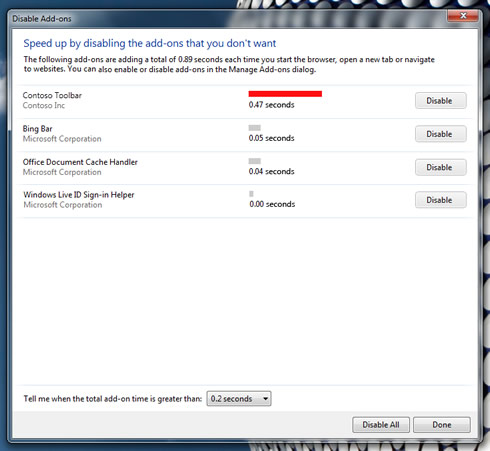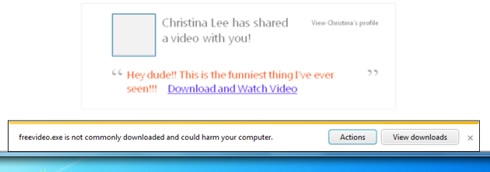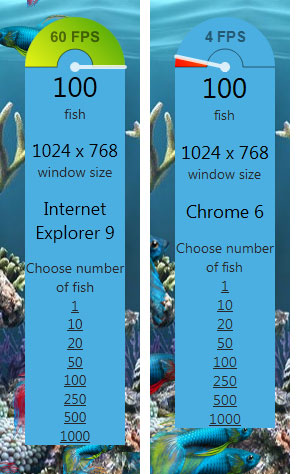
Microsoft Launches Internet Explorer 9 Beta
Microsoft's new Internet Explorer 9 beta was just released and includes hardware acceleration for snappy performance and a focuses on the web, Microsoft said.
At a launch event in San Francisco, Microsoft announced that the IE9 beta is now available in 33 languages worldwide for download. With a simple user interface that masks new technical muscle and all-around fast performance, the new browser is designed to take a backseat and bring forward the full beauty of the websites and applications people care about, says Dean Hachamovitch, Microsoft's corporate vice president for Internet Explorer.
Starting today, users can download the beta of IE9 and test drive the new browsing experience at some of the Web's most popular sites. At the event, sites such as Facebook, Twitter, MySpace and LinkedIn, and global brands such as Quiksilver, Red Bull, Livestrong and Amazon were showcasing experiences that take advantage of IE9's ability to tap into the power of the whole PC and modern standards such as HTML5 and to integrate sites seamlessly with Windows 7.
Some of the Web's top retailers plan to use IE9 to power improved browsing and purchasing experiences, including eBay, Microsoft said.
IE9 arrives with a more minimalist look and a few new tricks that start to blur the distinction between a website and a traditional desktop application.
Following the lead of Google Inc.'s stripped-down Chrome browser, Microsoft's IE9 comes with far fewer buttons, icons and toolbars cluttering up the top of the screen. Its frame is translucent, and as people browse the Web, IE9 can be subtly adorned with small icons and signature colors of the websites being viewed.

The focus on making website content shine is seen right in IE9's clean user interface, Hachamovitch says. By default, only the controls essential for browsing show up in the browser frame. That means less screen real estate is taken up by the browser, enabling people to see and experience more of what sites have to offer.
IE9 takes advantage of many features that will be familiar to Windows 7 users to keep the focus on content rather than the browser and make websites feel more like apps. For example, users can pin their favorite sites right to the Windows 7 taskbar, meaning they can access their favorite content without first having to open the browser. Jump Lists let users quickly access common tasks such as sending an email, playing a song, or keeping tabs on breaking news. And fans of Windows 7's Aero Snap feature will find it integrated into IE9, allowing them to quickly tear off tabs or place two sites side by side.

In addition to pinning sites to the Windows 7 taskbar, IE9 also picks up website branding, providing another way for users to feel immersed in the content, Hachamovitch says.
Microsoft also re-designed and re-wrote IE9's New Tab Page to be fast. In previous versions of IE, after users open a new tab, 47% of the time they just type in the address bar. Just as the address bar remembers where you've been and makes it easy to go back, this page adjusts to where you go on the web. This experience is for the vast majority of people who are looking for something that works with their typical usage, and not looking for more information and surface area to organize, manage, and "get right," Hachamovitch says.

IE9?s One Box combines the address bar and search box into a single edit control. It does not send your keystrokes to sites unless you tell it to:

With one click, you can get suggestions (typically visual suggestions), and turn the information flow on and off as you see fit. It's also easy to use many different search providers, as well as add more.
IE9 also makes significant progress with safety, reliability, performance and settings protection, and privacy.
Because add-ons are a key source of performance and reliability (and privacy) issues for consumers, IE9 provides information on the ongoing impact of add-ons on site performance and informs the user, so the user can stay in control of performance:

Microsoft is encouraging developers to see what?s new for them in IE9. The new browser gives them the ability to tap the power of PC hardware and improve all-around browsing performance. With IE9, Microsoft has shifted the rendering of graphics and text from the CPU to the computer's graphics processing unit, or GPU. That means Web developers can take advantage of the power that Windows developers have been tapping for years. Hardware-accelerated text, video and graphics, combined with a new JavaScript engine, means that websites can perform more like applications installed directly on a Windows computer.
Is that download really a screensaver, or actually malware? Most browsers leave that decision to the consumer without additional information or context. Just as IE8?s SmartScreen filter protects users from phishing and malware sites, IE9?s download manager offers users an early warning system against malware:

Aron Schoppert and Josh Santangelo of Stimulant gave the world a sense of IE9's technical muscle through WebVizBench, an HTML5 benchmark they built for the IE9 launch. Their benchmark measures what can be done with a browser that taps into the GPU, they say, and demonstrates how powerful IE9 is.

"Competing browsers that advertise hardware acceleration in their betas reach only half the frame rate and have a much poorer user experience," Schoppert says. "Users with low-end computers can upgrade their video card and have the experience be equivalent to buying a new computer with the results we are seeing with HTML5 Canvas and IE9. I think with HTML5 and what IE9 is doing, it's going to change the way the Web is viewed."
The journey to showcase Microsoft's IE9 partners in San Francisco has been underway ever since Internet Explorer 8 shipped in March 2009, Hachamovitch says. At the time, the browser competition was heating up and Microsoft's share of the browser market had fallen. But competition is never a bad thing for innovation, Gavin says. "With IE8, we have been talking to customers about our industry-leading focus on security, privacy and reliability, and that is something that got a positive response," Gavin says. "As a result of that conversation and a quality product, IE8 is not only the fastest-growing browser in history, it's the No. 1 browser across all operating systems."
Still, with IE losing overall share to competitors, the team looked at data that came from both inside and outside the company to see how it could do a better job with the next version of IE. The data they got back was humbling, Hachamovitch says, and they took it to heart. The team started to design their plan for IE9 around a few basic themes. First, it had to get faster. Second, they wanted to make the browsing experience and Windows better together. The third theme revolved around trust, meaning the browser had to focus on safety, reliability and privacy.
The result is IE9, a browser that transforms the capabilities of the Web, Hachamovitch says. During the development phase of building IE9, Microsoft worked hard to reach developers. Starting with MIX10, the company released a new version of the beta every eight weeks through its developer platform preview. To date, the IE9 platform previews have been downloaded more than 3 million times.
Hachamovitch believes that consumers will be drawn to the new browsing experience that IE9 offers, one that steps aside for the beauty of the Web.
The new browser works on PCs with Windows 7 or Vista, but not on PCs with the much more widely used Windows XP computers or on Macs.
Microsoft did not say when IE9 will leave the test phase, but the final version isn't likely to change much.
IE had 51 percent of the worldwide browser market last month, according to StatCounter, compared to Firefox's 31 percent and Chrome's 11 percent. Apple Inc's Safari and Opera Software's browser had about 4 percent and 2 percent.
Starting today, users can download the beta of IE9 and test drive the new browsing experience at some of the Web's most popular sites. At the event, sites such as Facebook, Twitter, MySpace and LinkedIn, and global brands such as Quiksilver, Red Bull, Livestrong and Amazon were showcasing experiences that take advantage of IE9's ability to tap into the power of the whole PC and modern standards such as HTML5 and to integrate sites seamlessly with Windows 7.
Some of the Web's top retailers plan to use IE9 to power improved browsing and purchasing experiences, including eBay, Microsoft said.
IE9 arrives with a more minimalist look and a few new tricks that start to blur the distinction between a website and a traditional desktop application.
Following the lead of Google Inc.'s stripped-down Chrome browser, Microsoft's IE9 comes with far fewer buttons, icons and toolbars cluttering up the top of the screen. Its frame is translucent, and as people browse the Web, IE9 can be subtly adorned with small icons and signature colors of the websites being viewed.

The focus on making website content shine is seen right in IE9's clean user interface, Hachamovitch says. By default, only the controls essential for browsing show up in the browser frame. That means less screen real estate is taken up by the browser, enabling people to see and experience more of what sites have to offer.
IE9 takes advantage of many features that will be familiar to Windows 7 users to keep the focus on content rather than the browser and make websites feel more like apps. For example, users can pin their favorite sites right to the Windows 7 taskbar, meaning they can access their favorite content without first having to open the browser. Jump Lists let users quickly access common tasks such as sending an email, playing a song, or keeping tabs on breaking news. And fans of Windows 7's Aero Snap feature will find it integrated into IE9, allowing them to quickly tear off tabs or place two sites side by side.

In addition to pinning sites to the Windows 7 taskbar, IE9 also picks up website branding, providing another way for users to feel immersed in the content, Hachamovitch says.
Microsoft also re-designed and re-wrote IE9's New Tab Page to be fast. In previous versions of IE, after users open a new tab, 47% of the time they just type in the address bar. Just as the address bar remembers where you've been and makes it easy to go back, this page adjusts to where you go on the web. This experience is for the vast majority of people who are looking for something that works with their typical usage, and not looking for more information and surface area to organize, manage, and "get right," Hachamovitch says.

IE9?s One Box combines the address bar and search box into a single edit control. It does not send your keystrokes to sites unless you tell it to:

With one click, you can get suggestions (typically visual suggestions), and turn the information flow on and off as you see fit. It's also easy to use many different search providers, as well as add more.
IE9 also makes significant progress with safety, reliability, performance and settings protection, and privacy.
Because add-ons are a key source of performance and reliability (and privacy) issues for consumers, IE9 provides information on the ongoing impact of add-ons on site performance and informs the user, so the user can stay in control of performance:

Microsoft is encouraging developers to see what?s new for them in IE9. The new browser gives them the ability to tap the power of PC hardware and improve all-around browsing performance. With IE9, Microsoft has shifted the rendering of graphics and text from the CPU to the computer's graphics processing unit, or GPU. That means Web developers can take advantage of the power that Windows developers have been tapping for years. Hardware-accelerated text, video and graphics, combined with a new JavaScript engine, means that websites can perform more like applications installed directly on a Windows computer.
Is that download really a screensaver, or actually malware? Most browsers leave that decision to the consumer without additional information or context. Just as IE8?s SmartScreen filter protects users from phishing and malware sites, IE9?s download manager offers users an early warning system against malware:

Aron Schoppert and Josh Santangelo of Stimulant gave the world a sense of IE9's technical muscle through WebVizBench, an HTML5 benchmark they built for the IE9 launch. Their benchmark measures what can be done with a browser that taps into the GPU, they say, and demonstrates how powerful IE9 is.

"Competing browsers that advertise hardware acceleration in their betas reach only half the frame rate and have a much poorer user experience," Schoppert says. "Users with low-end computers can upgrade their video card and have the experience be equivalent to buying a new computer with the results we are seeing with HTML5 Canvas and IE9. I think with HTML5 and what IE9 is doing, it's going to change the way the Web is viewed."
The journey to showcase Microsoft's IE9 partners in San Francisco has been underway ever since Internet Explorer 8 shipped in March 2009, Hachamovitch says. At the time, the browser competition was heating up and Microsoft's share of the browser market had fallen. But competition is never a bad thing for innovation, Gavin says. "With IE8, we have been talking to customers about our industry-leading focus on security, privacy and reliability, and that is something that got a positive response," Gavin says. "As a result of that conversation and a quality product, IE8 is not only the fastest-growing browser in history, it's the No. 1 browser across all operating systems."
Still, with IE losing overall share to competitors, the team looked at data that came from both inside and outside the company to see how it could do a better job with the next version of IE. The data they got back was humbling, Hachamovitch says, and they took it to heart. The team started to design their plan for IE9 around a few basic themes. First, it had to get faster. Second, they wanted to make the browsing experience and Windows better together. The third theme revolved around trust, meaning the browser had to focus on safety, reliability and privacy.
The result is IE9, a browser that transforms the capabilities of the Web, Hachamovitch says. During the development phase of building IE9, Microsoft worked hard to reach developers. Starting with MIX10, the company released a new version of the beta every eight weeks through its developer platform preview. To date, the IE9 platform previews have been downloaded more than 3 million times.
Hachamovitch believes that consumers will be drawn to the new browsing experience that IE9 offers, one that steps aside for the beauty of the Web.
The new browser works on PCs with Windows 7 or Vista, but not on PCs with the much more widely used Windows XP computers or on Macs.
Microsoft did not say when IE9 will leave the test phase, but the final version isn't likely to change much.
IE had 51 percent of the worldwide browser market last month, according to StatCounter, compared to Firefox's 31 percent and Chrome's 11 percent. Apple Inc's Safari and Opera Software's browser had about 4 percent and 2 percent.





















